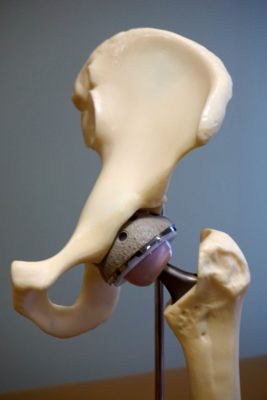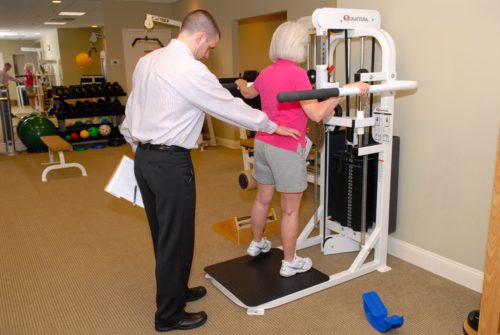By Matthew Marucci
There are few muscle groups in the body more important than those of the hip. In addition to influencing the hip, these muscles can impact the health of your lumbar spine and knees.
 When people think about keeping their knees healthy the most common approach is strengthening the quadriceps. While there is nothing wrong with working the quadriceps, the hip, particularly the gluteal muscles, have significantly more influence on the health of your knees. The gluteals help control the position of your femur (thigh bone) and thus the alignment with the tibia (shin bone). Misalignment between these bones can increase the stress placed on the cartilage in your knees and hips. Additionally, if you lack proper alignment between your femur and tibia, the significance of your quadriceps strength decreases even further.
When people think about keeping their knees healthy the most common approach is strengthening the quadriceps. While there is nothing wrong with working the quadriceps, the hip, particularly the gluteal muscles, have significantly more influence on the health of your knees. The gluteals help control the position of your femur (thigh bone) and thus the alignment with the tibia (shin bone). Misalignment between these bones can increase the stress placed on the cartilage in your knees and hips. Additionally, if you lack proper alignment between your femur and tibia, the significance of your quadriceps strength decreases even further.
 Another common misperception is that activities like running and cycling strengthen your hips. To increase the strength of a muscle you must use enough weight or resistance to reach fatigue in the range of 12-15 repetitions. While running and cycling are excellent forms of cardiovascular exercise, they do little to strengthen your legs. Cardiovascular exercises also tend to engage your muscles in the sagittal plane (front to back movement), while the gluteal muscles need rotation or movement away from the body to be recruited.
Another common misperception is that activities like running and cycling strengthen your hips. To increase the strength of a muscle you must use enough weight or resistance to reach fatigue in the range of 12-15 repetitions. While running and cycling are excellent forms of cardiovascular exercise, they do little to strengthen your legs. Cardiovascular exercises also tend to engage your muscles in the sagittal plane (front to back movement), while the gluteal muscles need rotation or movement away from the body to be recruited.
The influence of the hip on the spine is simply an equation of motion. The more motion that can be derived from the hips, the less motion will be needed from the spine. Less motion in the spine results in decreased stress placed upon the vertebral discs and ligaments. Minimizing motion from the spine and adding lumbar stabilization exercises (planks, side planks) to your routine is a great recipe for a healthy spine.
Try adding these exercises to your routine.
Clamshells: Lie on your side with your hips and knees bent. Slowly lift your top knee while keeping your feet together. Stop when you feel your pelvis begin to tip backwards.
To add resistance use an ankle weight wrapped around your top thigh or an elastic exercise band around your knees. Perform 3 sets of 12 repetitions.
Side Lying Hip Abduction: Lie on your side with your bottom leg pulled up toward your chest. Lift the top leg up and slightly back. You know you are performing this properly when you feel the back half of your glutes working. You should not feel it on the side of your hip. Perform 3 sets of 12 repetitions.
Modified Side Plank with Hip Abduction: Lie on your side with your knees bent and lift your body off the ground using your elbow and knee closest to the ground. While holding this position gently lift your top leg up and slightly back. Hold the side plank for 30 seconds and try to raise your leg about 15 times during the 30 second period.
Matthew Marucci PT, MSPT, OCS, CSCS is the owner of New Castle Physical Therapy & Personal Training and is certified as an Advanced Hip Clinician with The Hospital for Special Surgery.
